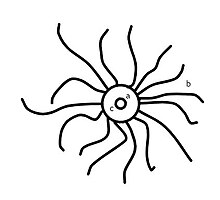| Hiemalora Temporal range: Ediacaran, 565–550 Ma PreꞒ Ꞓ O S D C P T J K Pg N | |
|---|---|

| |
| Hiemalora stellaris The German text says "imprint of a jellyfish". | |
| Scientific classification | |
| Kingdom: | Incertae sedis |
| Genus: | †Hiemalora Fedonkin 1982 |
| Type species | |
| †Hiemalora stellaris | |
| Species | |
| |
| Synonyms | |
| |

Hiemalora is a fossil of the Ediacaran biota, reaching around 3 cm in diameter, which superficially resembles a sea anemone. The genus has a sack-like body with faint radiating lines originally interpreted as tentacles, but discovery of a frond-like structure seemingly attached to some Heimalora has added weight to a competing interpretation: that it represents the holdfast of a larger organism.
In 2020, a new study was published that described nine different specimens from the Indreelva member, Digermulen Peninsula, Finnmark (Arctic Norway). The specimens described in the paper have high degrees of variation between morphologies and within the specimens that are thought to be of the same species. Some of the representative fossils from that paper either show multiple Aspidella-like structures on the same specimen, or a Primocandelabrum-like cone visible in one of the fossils. All of the examples of fossils in the publication were determined to most likely represent the species Hiemalora stellaris, however, one of the more poorly preserved specimens (D18-50) is thought to have been representative of Hiemalora pleiomorphus, although the latter of the species represented by the specimens does not show parallel ridges running along the poorly preserved central disc. A representative of H, stellaris might have represented a holdfast with a Primocandelabrum frond attached to it, which may further support the theory of Hiemalora being a holdfast for Primocandelabrum.
This interpretation would stand against its original classification in the medusoid Cnidaria; it would also consign a once-popular hypothesis placing Hiemalora in the chondrophores, on the basis of its tentacle structure, to the dustbin. Studies testing the feasibility of the hypothesis investigated the possibilities that such fragile tentacles could be preserved, and concluded that it would be very improbable — especially as many Hiemalora bearing beds also contain such fossils as Cyclomedusa, but do not preserve the tentacles on these organisms.
Hiemalora has been identified in a wide range of facies and locations globally.
Etymology
The genus was originally named Pinegia, but was renamed two years later when it was realised that a genus of Permian insect already bore the name. The revised name comes from Latin hiemalis ora, "winter coast".
See also
References
- Chen, Zhe; Zhou, Chuanming; Xiao, Shuhai; Wang, Wei; Guan, Chengguo; Hua, Hong; Yuan, Xunlai (2014). "New Ediacara fossils preserved in marine limestone and their ecological implications". Scientific Reports. 4: 4180. Bibcode:2014NatSR...4.4180C. doi:10.1038/srep04180. PMC 3933909. PMID 24566959.
- Fedonkin, Mikhail A.; Sciences), Mikhail A. (Head Fedonkin, Laboratory of Precambrian Organisms Russian Academy of; Gehling, James G.; Museum), James G. (Senior Curator Gehling, retired 6 27 2019 South Australian; Grey, Kathleen; Narbonne, Guy M.; Vickers-Rich, Patricia; University), Patricia (Director Vickers-Rich, Monash (Mar 16, 2007). The Rise of Animals: Evolution and Diversification of the Kingdom Animalia. JHU Press. ISBN 9780801886799. Retrieved July 9, 2022 – via Google Books.
{{cite book}}: CS1 maint: multiple names: authors list (link) CS1 maint: numeric names: authors list (link) - Hofmann, H.J. (2005). "HIEMALORA AND OTHER EDIACARAN FOSSILS OF NORTHEASTERN NEWFOUNDLAND, AND CORRELATIONS WITHIN AVALONIA". Geological Society of America Abstracts with Programs. 37 (7): 485. Archived from the original on 2008-10-10. Retrieved 2007-08-20.
- ^ Nicholas, Hodby (March 2020). "The Enigmatic Fossil Hiemalora in the Ediacaran of the Digermulan Peninsula".
{{cite journal}}: Cite journal requires|journal=(help) - Seilacher, A.; Buatois, L.A.; Gabriela Mangano, M. (2005). "Trace fossils in the Ediacaran-Cambrian transition: Behavioral diversification, ecological turnover and environmental shift". Palaeogeography, Palaeoclimatology, Palaeoecology. 227 (4): 323–356. Bibcode:2005PPP...227..323S. doi:10.1016/j.palaeo.2005.06.003.
- ^ Narbonne, G.M. (1994). "New Ediacaran Fossils from the Mackenzie Mountains, Northwestern Canada". Journal of Paleontology. 68 (3): 411–416. Bibcode:1994JPal...68..411N. doi:10.1017/S0022336000025816. JSTOR 1306192. S2CID 133215767.
- Waggoner, B. (1998). "The Ediacaran Biotas in Space and Time". Integrative and Comparative Biology. 43 (1): 104–113. doi:10.1093/icb/43.1.104. PMID 21680415.
- Fedonkin, M.A. (1980). "New representatives of the Precambrian coelenterates in the northern Russian platform". Paleontologicheskii Zhurnal (in Russian). 2: 7–15.
- Fedonkin, M.A. (1982). "New generic name for the Precambrian coelenterates". Paleontologicheskii Zhurnal (in Russian). 2: 137.
External links
- Image Archived 2006-06-12 at the Wayback Machine
| Taxon identifiers | |
|---|---|
| Hiemalora | |
This prehistoric biota article is a stub. You can help Misplaced Pages by expanding it. |